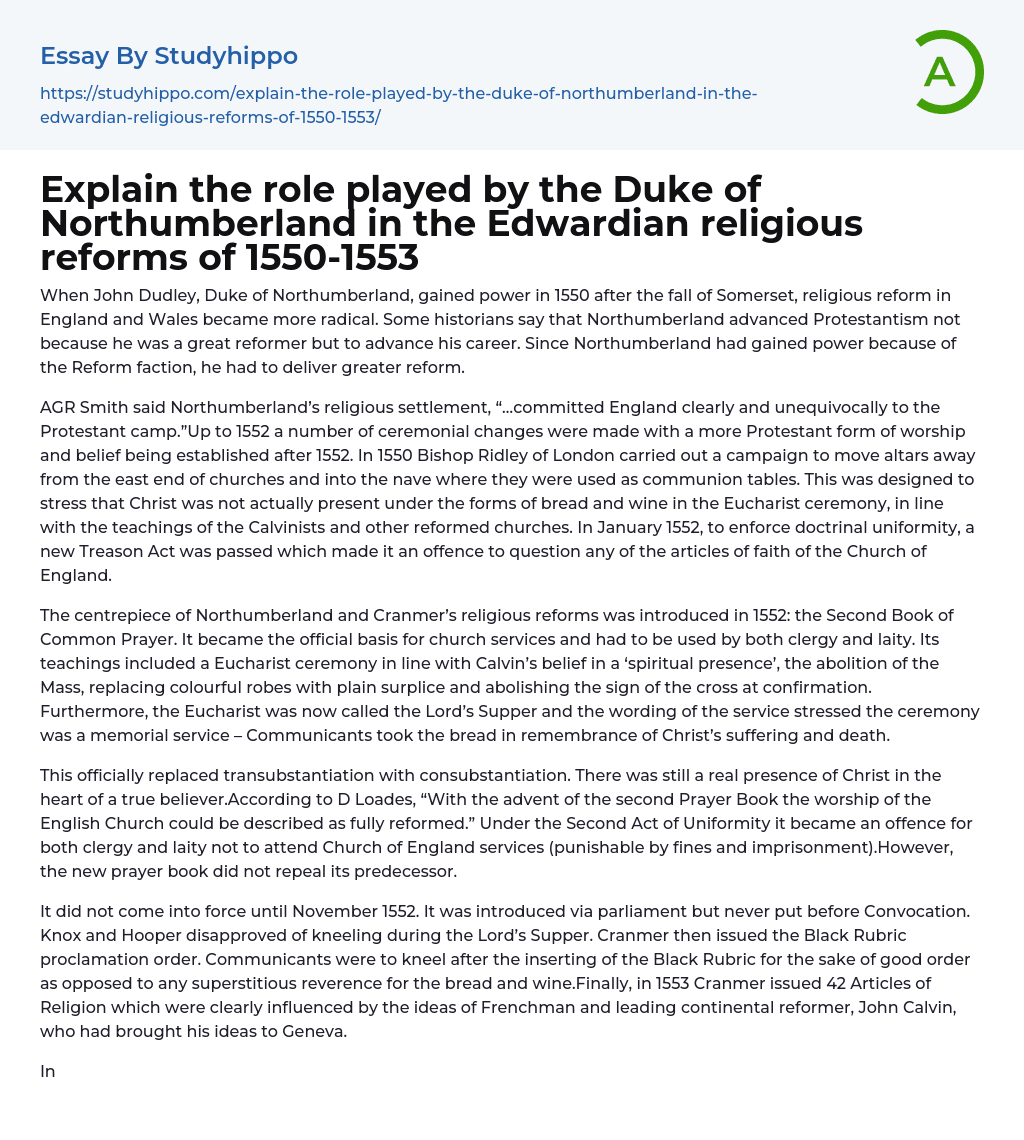When John Dudley, Duke of Northumberland, gained power in 1550 after the fall of Somerset, religious reform in England and Wales became more radical. Some historians say that Northumberland advanced Protestantism not because he was a great reformer but to advance his career. Since Northumberland had gained power because of the Reform faction, he had to deliver greater reform.
AGR Smith said Northumberland’s religious settlement, “…committed England clearly and unequivocally to the Protestant camp.”Up to 1552 a number of ceremonial changes were made with a more Protestant form of worship and belief being established after 1552. In 1550 Bishop Ridley of London carried out a campaign to move altars away from the east end of churches and into the nave where they were used as communion tables. This was designed to stress that Christ was no
...t actually present under the forms of bread and wine in the Eucharist ceremony, in line with the teachings of the Calvinists and other reformed churches. In January 1552, to enforce doctrinal uniformity, a new Treason Act was passed which made it an offence to question any of the articles of faith of the Church of England.
The centrepiece of Northumberland and Cranmer’s religious reforms was introduced in 1552: the Second Book of Common Prayer. It became the official basis for church services and had to be used by both clergy and laity. Its teachings included a Eucharist ceremony in line with Calvin’s belief in a ‘spiritual presence’, the abolition of the Mass, replacing colourful robes with plain surplice and abolishing the sign of the cross at confirmation. Furthermore, the Eucharist was now called the Lord’s Supper and the wording of
the service stressed the ceremony was a memorial service – Communicants took the bread in remembrance of Christ’s suffering and death.
This officially replaced transubstantiation with consubstantiation. There was still a real presence of Christ in the heart of a true believer.According to D Loades, “With the advent of the second Prayer Book the worship of the English Church could be described as fully reformed.” Under the Second Act of Uniformity it became an offence for both clergy and laity not to attend Church of England services (punishable by fines and imprisonment).However, the new prayer book did not repeal its predecessor.
It did not come into force until November 1552. It was introduced via parliament but never put before Convocation. Knox and Hooper disapproved of kneeling during the Lord’s Supper. Cranmer then issued the Black Rubric proclamation order. Communicants were to kneel after the inserting of the Black Rubric for the sake of good order as opposed to any superstitious reverence for the bread and wine.Finally, in 1553 Cranmer issued 42 Articles of Religion which were clearly influenced by the ideas of Frenchman and leading continental reformer, John Calvin, who had brought his ideas to Geneva.
In particular his contentious idea of predestination now became part of the English churches’ theology. It also proclaimed the centrality of the Bible to matters of doctrine, ceremony and salvation. It never became law.To conclude, Northumberland made radical changes, but many were not in force for very long (such as the 48 articles). It is generally agreed that by 1553 the Edwardian Reformation had resulted in a Church of England that was thoroughly Protestant but there is insufficient evidence
to decide whether the people of England had wholeheartedly embraced Protestantism. According to GR Elton, “The Edwardian Reformation was superficial – imposed on a reluctant or indifferent people by a few ardent spirits and the politicians.”
- Travel essays
- Asia essays
- Caribbean essays
- Developing Country essays
- America essays
- City essays
- Africa essays
- Australia essays
- Europe essays
- Georgia essays
- Middle East essays
- New Zealand essays
- South Korea essays
- Thailand essays
- Afghanistan essays
- Dubai essays
- North Korea essays
- Natural Disaster essays
- Earthquake essays
- Fracking essays
- Mountains essays
- Restaurant essays
- Hospitality essays
- Business Travel essays
- Hotels essays
- Tourism essays
- World Tourism Organization essays
- Kids travel essays
- Travel Agency essays
- ecotourism essays
- Air Travel essays
- Sea Travel essays
- Cathedral essays
- Traveling essays
- Fast Food Restaurant essays
- Motel essays
- Cultural Tourism essays
- The real essays
- Airlines essays
- Airports essays
- Boeing essays
- Low-Cost Carrier essays
- Easyjet essays
- Bangladesh essays
- Kuala Lumpur essays
- Malaysia essays
- Manila essays
- Philippines essays
- Singapore essays
- Vietnam essays




